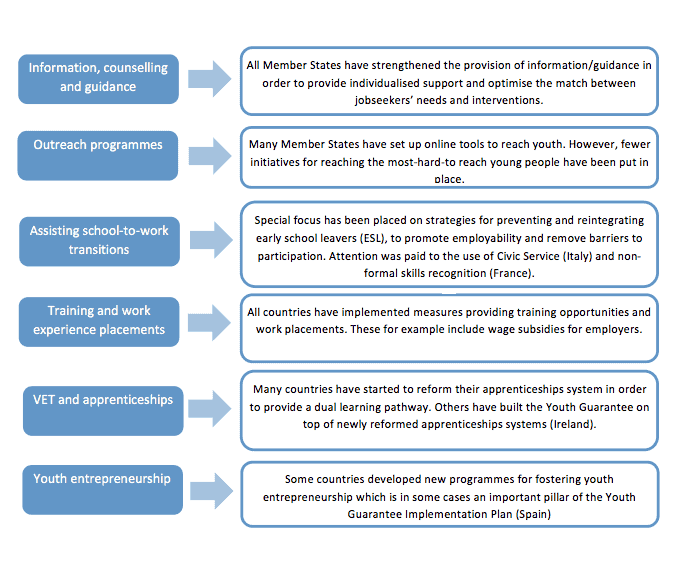In 2013, youth unemployment rates in Europe reached the highest level ever recorded in the history of the EU and in the majority of the Member States (MS). More than 5.5 million young people aged 15-24 were unemployed (now more than 4.5m), with a huge sense of crisis and the fear that the youth unemployment “bomb” would explode soon. Deeply concerned about the risk of a “lost generation”, the European Council proposed the Youth Guarantee: a pledge to provide the offer of education, training or employment, to all young people aged 15-24 within four months after becoming unemployed – and invited all the MS for its rapid implementation.
With a swift answer to this call, all MS started putting into practise this new policy framework and put in place immediate measures for bringing young people back into education or employment. However, two years after its launch and with the youth unemployment rate still above 20%, in some MS the Guarantee still appears to be like a Copernican revolution in youth policies that will take time and costly major reforms to be fully completed.
Youth Guarantee implementation – Steps taken so far
The Youth Guarantee underwent a very rapid implementation. Following the 2013 Council Recommendation, Member States presented their national Youth Guarantee Implementation Plans (YGIPs) adapting this overall policy framework to their national, regional and local requirements and labour market structures. Already in 2014 they adopted the first concrete actions to fulfil the aim of the Youth Guarantee.
In doing so, Member States have adopted different implementation strategies. Some, such as France, have chosen a more holistic approach using the Youth Guarantee as a means of improving links between labour market, education and Vocational Educational Training (VET) provisions as well as youth and social policies more generally. Other countries, such as Spain or Greece, opted for a narrower approach – predominantly focussing on employment and on the labour market dimension.
As the Council recommended, all countries have sought to improve stakeholder cooperation in effectively overcoming the fragmentation of youth policies as well as putting in place IT tools in order to strengthen their capacity for reaching out to young people.
Given the composition of the youth population and the local dynamics of school-to-work transitions, some Member States, such as Italy, have extended the population of NEETs covered by this initiative to 15-29 year-olds. While the extension of the age group positively increased the number of potential participants, from 1.2m to 2.2m in the case of Italy, it also heaped an extra heavy workload onto (already over-stretched) Public Employment Services (PES).
Concrete implementation measures put in place can be grouped along the following six main categories:

Youth guarantee, the Copernican revolution and the challenges ahead
Member States may have applied different strategies but adopted similar policy tools. However, a range of challenges goes hand in hand with the implementation of a major policy framework such as the Youth Guarantee: so much so that in some countries it resembles a Copernican revolution in youth policies.
The Guarantee’s effectiveness is assured by three main factors: better coordinated policies for youth; early activation of the young job seeker status, limiting the risk of long term disengagement from the labour market; individualised approach to the job seeker, ensuring an optimal matching between the needs of the jobless and the opportunity received, maximising in this way its effectiveness and the chances of his/her re-integration into the labour market. These three main factors are based on a full and working partnership among all stakeholders and labour market actors as well as on well-developed PES, able to deliver the wide range of tasks required. Unfortunately, these ingredients seem to be missing in some Member States where the PES are not ready for full and timely provision of the services required within the Guarantee while lack of trust among various actors makes the achievement of a well-functioning partnership hard to achieve.
However, besides putting in place immediate measures for bringing young people back into education or employment, the Guarantee entails long-term reforms to improve the capacity and capabilities of PES targeted at young people. Reforming such structures and adapting them more readily to the labour market needs of young people is a long-term project which can be costly. However, and despite recent labour market improvements, such reforms need to move ahead, with all stakeholders and labour market actors working together to ensure that this Copernican revolution is completed and the Guarantee delivers its ambitious promises.
During the first year, given the scale of youth unemployment and the above limitations, a number of MS opted for a more pragmatic approach to implementation by focusing their offer on those young people who are more ‘job-ready’ and likely to be more easily re-integrated into the labour market. However, given that long term unemployment for young people can indeed lead to a lifelong disengagement from the jobs market, further efforts and initiatives aimed at reaching out to hard-to-reach youth should be designed and implemented. In 2014 in Europe, only 57% of young NEETs were registered at the relevant PES. Improving those services and encouraging young people to be registered by overcoming their scepticism is crucial as registration is the entry point to access the scheme.
Finally, providing young people with good quality, sustainable opportunities under the Guarantee framework is central to the success of this new policy approach and several stakeholders have repeatedly expressed their concerns about the quality dimension of offers. For now, in the majority of MS, the Guarantee resembles a ‘guarantee of opportunity’ (ensuring that all young people will receive an offer within the four months) rather than a ‘guarantee of outcome’ (the (re-)entry of youth into the labour market). Moving the target from opportunity to outcome would be be a valuable extension of the current Guarantee in the long run. Strengthening this quality dimension and providing sustainable training and/or employment opportunities for young people is a much more effective means of re-integrating youth within the labour market.
Massimiliano Mascherini Is head of the social policies unit at Eurofound, having joined the organisation in 2009 as a research manager. He has a PhD in applied statistics from the University of Florence and has been a visiting fellow at the University of Sydney and Aalborg University.

